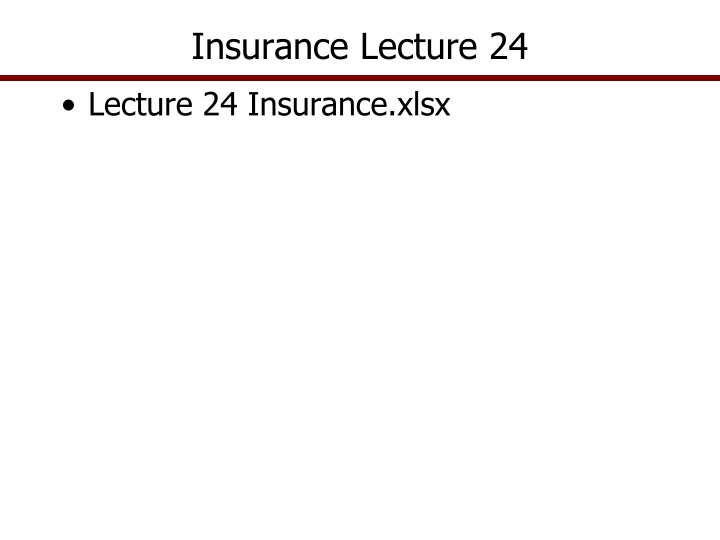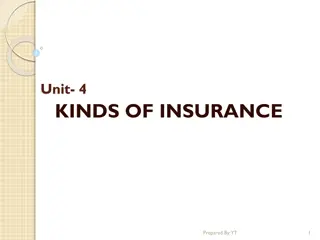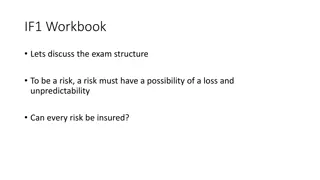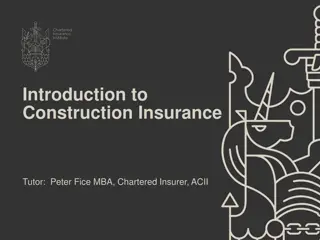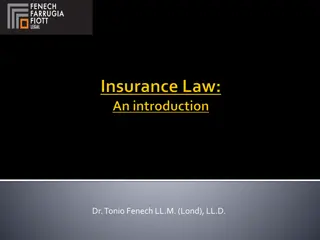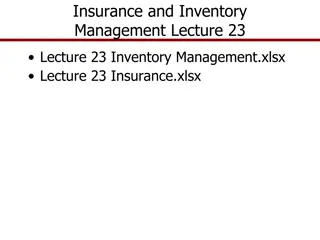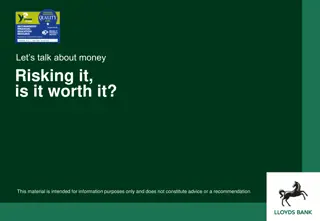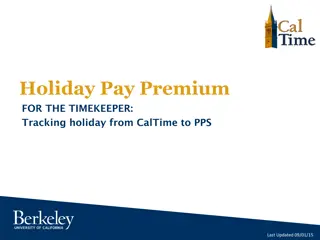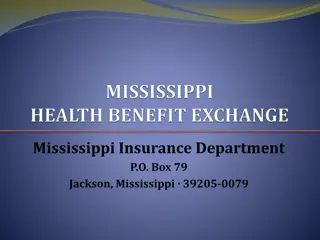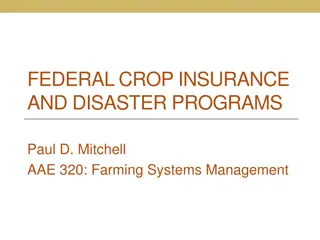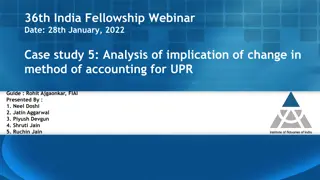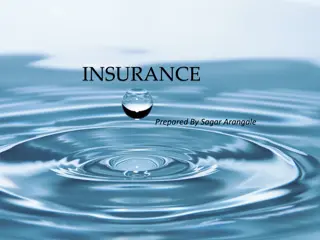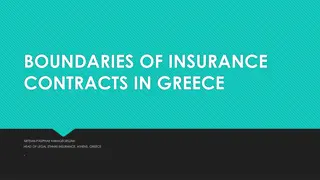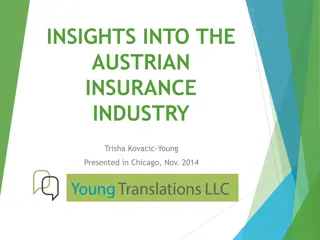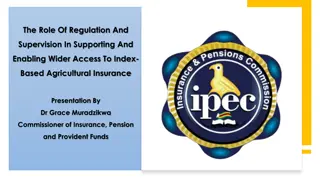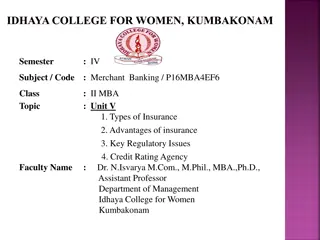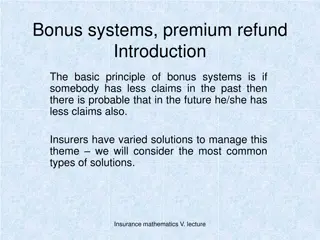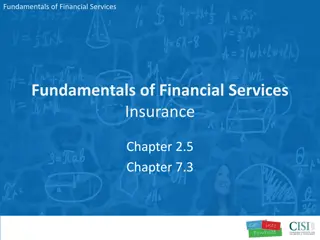Insurance Lecture 24: Understanding Risks and Premium Calculation
Insurance is a risk management tool used to protect against various risks such as fire, hail, drought, and floods. This lecture discusses the principles of insurance, terms related to insurance policies, premium calculation methods, and insurance specific to agriculture. It also sheds light on the unique challenges of agriculture insurance and the role of government agencies in providing coverage. Additionally, the content touches on current drought conditions in the US, highlighting Texas's relative resilience compared to previous years.
Download Presentation

Please find below an Image/Link to download the presentation.
The content on the website is provided AS IS for your information and personal use only. It may not be sold, licensed, or shared on other websites without obtaining consent from the author.If you encounter any issues during the download, it is possible that the publisher has removed the file from their server.
You are allowed to download the files provided on this website for personal or commercial use, subject to the condition that they are used lawfully. All files are the property of their respective owners.
The content on the website is provided AS IS for your information and personal use only. It may not be sold, licensed, or shared on other websites without obtaining consent from the author.
E N D
Presentation Transcript
Insurance Lecture 24 Lecture 24 Insurance.xlsx
Principal of Insurance Insurance is a risk management tool Buy insurance to cover a specific risk of a loss to the business Low yield due to fire, hail, drought, flood, etc. Low prices Low revenue due to low production of price Health, auto, and home insurance most popular Liability insurance Insurance transfers a part of the risk to a third party
Terms for an Insurance Policy States risk to protect against Conditions for a loss Amount of loss that must occur for a payment States the premium to be paid States indemnity payment conditions Amount of the deductible (losses not paid) Formula for calculating a payment
Insurance Premiums Premiums are set to cover the expected loss plus a risk premium and a profit for the insurance company Premium = E(losses) + RP + Profit Calculate the E(Losses) with simulation Simulate the type of loss and use the losses in the formula for calculating the premium Calculate the average loss over a given time period, usually a year Profit is a set fraction by the company RP covers risk not fully captured in PDF for risk
Insurance for Agriculture Crop Yield insurance Low yields insured against hail, fire, insects, drought, flood Revenue insurance Protects crop farmers from low revenues relative to historical averages
Agriculture Insurance Presents Unique Problems Agricultural risks widespread due to weather affecting large regions when drought of occur If an insurance co. covered all the risk they would be wiped out Solution was for the federal government to back up these companies USDA-Risk Management Agency (RMA) write insurance policies and set premiums and terms Private cos. sell these policies Sell most policies to RMA, keep the lower risk policies as an investment
Texas is actually looking pretty good relative to 2011 September 13, 2011 February 3, 2015 but parts of Texas are still in an exceptional, multi-year drought
Brief History of Federal Crop Insurance 1930 s USDA offered yield insurance in the Great Plains for wheat Experimental project Expanded to other crops gradually 1971 Farm program offered Disaster Program Paid farmers for low yield and prevented plantings Replaced with FCIC insurance in 1983 In 83 FCIC yield insurance expanded to all crops in all counties
FCIC Yield Insurance Production guarantee = APH * coverage level percentage elected APH = 10 year yield history on the farm unit Premium set by RMA based on announced price guarantee and coverage level percentage Indemnity = Max[0, (Actual Yield Production Guarantee) * Projected Price * Acreage Covered]
FCIC Yield Insurance 50 acres of corn, RMA projected price of $3.50/bu, APH yield 145 bu/acre, 85% coverage level Production guarantee = 0.85 * 145 = 123.3 If actual yield = 115 so lost yield is 123.3-115 Indemnity = (123.3-115) * 2.25 * 50
Revenue Insurance Crop Revenue Coverage (CRC) Producers buy a fraction of the historical revenue 65% to 85% in 5% fractions Insure with a projected price or the harvest price Indemnity = Max[0, (Guaranteed Revenue Actual Revenue) * Acres ] Actual Revenue = actual yield * (RMA projected price OR harvest time price)
Revenue Insurance 50 acres of corn, RMA projected price of $3.50/bu, APH yield 145 bu/acre, 85% coverage level Revenue guarantee = 50 * 145 * 0.85 * 3.50 Actual yield = 100 Indemnity = Max[0, (revenue guarantee 50 * 100 * 3.50 or actual harvest time price)] Electing the RMA projected price is referred to Harvest Price Exclusion and is cheaper
Analyzing Insurance Options Simple simulation problem Simulate yield and price Compare yield or revenue to alternative coverage levels, calculate indemnities and premiums Pick insurance policy which is best at reducing risk and increasing net income, NPV, or cash flows
RMA Insurance Policies General Policies and Provisions Insurance policies must be purchased prior to planting to reduce: Moral hazard -- buying insurance when farmers know the crop will fail xxx Actual Revenue History (ARH) Pilot Endorsement (14-arh). Area Risk Protection Insurance (14-ARPI) Commodity Exchange Price Provisions (CEPP) Catastrophic Risk Protection Footnote 5. Ineligibility Amendment (15-Ineligibility) Footnote 1. Farm Bill Amendment (15-ARPI-Farm-Bill) Footnote 6. Catastrophic Risk Protection Endorsement (15-cat). Footnote 3. Common Crop Insurance Policy, Basic Provisions (11-br) Commodity Exchange Price Provisions (CEPP) Contract Price Addendum (CPA) Ineligibility Amendment (15-Ineligibility) Footnote 1. Farm Bill Amendment (15-CCIP-Farm-Bill) Footnote 2. Other Information Supplemental Coverage Option (SCO-15) High-Risk Alternate Coverage Endorsement (HR-ACE)(13-HR-ACE) High-Risk Alternate Coverage Endorsement Standards Handbook High-Risk Alternate Coverage Endorsement Frequently Asked Questions Livestock Quarantine Endorsement Pilot (11-qe). Rainfall and Vegetation Indices Pilot Whole-Farm Revenue Protection (WFRP) Pilot Policy
Insurance and Farm Policy 2014 Farm Bill is relying more on insurance and less on direct or indirect subsidies Agricultural Risk Coverage (ARC) Supplemental Crop Optionm(SCO)
Agriculture Risk Coverage (ARC-CO) Payments when actual revenue for the covered commodity < ARC revenue guarantee, where: Actual County Revenue = Actual county yield per planted acre * Max of {National Marketing Year Price or Marketing Loan Rate} ARC Revenue Benchmark = (5 Year U.S. Olympic average marketing year price) * (5 Year Olympic average county) If any of the 5 years of prices are lower than Reference Price then replace with the Reference Price. If the actual county yield is < 70% of T-yield replace with the T-yield. ARC Revenue Guarantee = 0.86 * ARC Revenue Benchmark ARC Payment = Minimum of [(ARC Revenue Guarantee Actual County Revenue) OR 10% of the ARC Revenue Benchmark] * Base Acres * 0.85 No yield risk in year one s calculation but that does not last Olympic average starts with 2009-2013, but then moves to 2010-2014, 2011-2015, 2012-2016, 2013-2017 with more and more risky yields in the Olympic Average each year of the farm program
Illustration of Government Support for Grains Under ARC-County Revenue per cwt or bu Revenue Benchmark 86% of Revenue Guarantee 86% 76% [paid on base acres x .65 (individual) or .85 (county)] Loan Rate MLG Market Price Market Receipts Crop insurance coverage
Supplemental Coverage Option (SCO) Gap insurance: payments for losses from 86% of APH or CRC coverage level down to the underlying insurance coverage level
Illustration of Government Support for Rice Under SCO Revenue per cwt 86% of Revenue Guarantee Supplemental Coverage Option Crop insurance coverage
Insurance Job Opportunities Sales repre s for the large companies Insurance actuarialists Adjusters Seasonal employment that pays well Work during growing season only Visit damaged fields and prepare estimates of the damages Experience with crop production and economics Insurance companies complain there never enough adjusters
Insurance Use in Texas for Cotton 0.5 0.55 0.6 0.65 0.7 0.75 0.8 0.85 410,813 138,146 2,384,361 2,035,135 4,472,480 9,831,329 508,302 15,533 Acres of Cotton Participating in Crop Insurance in TX by Coverage Level 12,000,000 10,000,000 240 650 8,000,000 23249 4146 113 6,000,000 4,000,000 14 465 105 2,000,000 4 - 170 387 44 0.5 0.55 0.6 0.65 0.7 0.75 0.8 0.85
Insurance Use in Texas for Corn 0.5 0.55 0.6 0.65 0.7 0.75 0.8 0.85 147,477 Acres of Corn Participating in Crop Insurance in TX by Coverage Level 17,136 210,009 304,214 716,190 1,035,911 200,897 52,649 1,200,000 1,000,000 800,000 600,000 400,000 200,000 SUM - 0.5 0.55 0.6 0.65 0.7 0.75 0.8 0.85
Learning Curve or Demand Cycle A new business may need a few months or years to grow sales to their potential May take months or years to learn how to reach potential for a prod function In either case, assume a stochastic growth function and simulate it, if nothing else is available, use a Uniform distribution Example of a growth function for 8 years
Learning Curve or Demand Cycle Fan Graph for Realized Sales over 10 Years 250,000 200,000 150,000 100,000 50,000 - Sales1 Sales3 Sales5 5th Percentile 95th Percentile Sales7 Sales9 25th Percentile Average 75th Percentile
Life Cycle Costing A new concept in project feasibility analysis Explicitly consider externalities Such as cleanup costs at end of business Strip mining reclamation Removal of underground fuel tanks Removal of above ground assets Restoration of site Prevention of future environmental hazards Removal of waste materials 100 year liners for ponds
Life Cycle Costing Steps to Life Cycle Costing Analysis Identify the potential externalities Determine costs of these externalities Assign probabilities to the chance of experiencing each potential cost Assume distributions with GRKS or Bernoulli Simulate costs given the probabilities Incorporate costs of cleanup and prevention into the project feasibility These terminal costs may have big Black Swans so prepare the investor
Life Cycle Costing Bottom line is that LCC will increase the costs of a project and reduce its feasibility Affects the downside risk on returns Does nothing to increase the positive returns Need to consider the FULL costs of a proposed project to make the correct decision J. Emblemsvag Life Cycle-Costing: Using Activity-Based Costing and Monte Carlo Simulation to manage Future Costs and RisksJohn Wiley & Sons Inc. 2003
Life Cycle Analysis LCA is a tool for determining the impact of a new process or project on the environment and climate change LCAs are concerned with quantifying Energy Use and CO2 Balance Green House Gases (GHGs) Water use and indirect Land use Nutrient (N,P,K) use and other factors Thus far these are deterministic analyses This will soon change
Life Cycle Analysis For those interested in a good example of LCA see MS thesis in our Department by Chris Rutland
